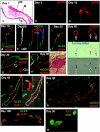Vascular morphogenesis and differentiation after adoptive transfer of human endothelial cells to immunodeficient mice
- PMID: 12000715
- PMCID: PMC1850884
- DOI: 10.1016/S0002-9440(10)61110-8
Vascular morphogenesis and differentiation after adoptive transfer of human endothelial cells to immunodeficient mice
Abstract
To establish a model for adoptive transfer of endothelial cells, we transferred human umbilical vein endothelial cells (HUVECs) to immunodeficient mice (Rag 2(-/-)). HUVECs were suspended as single cells in Matrigel and injected subcutaneously in the abdominal midline. Within 10 days after injection, HUVECs expressed pseudopod-like extensions and began to accumulate in arrays. By day 20, we observed human vessels that contained erythrocytes, and on day 30 we observed perivascular cells that expressed smooth muscle actin, thus resembling mature vessels. Throughout the experimental period, HUVECs bound Ulex europaeus lectin and expressed CD31, VE-cadherin, von Willebrand factor, as well as ICAM-2. A fraction of the cells also expressed the proliferation marker Ki67. Moreover, the sialomucin CD34, which is rapidly down-regulated in cultured HUVECs, was reinduced in vivo. However, we found no reinduction of CD34 in cells cultured inside or on top of Matrigel in vitro. We also injected cells suspended in Matrigel around the catheter tip of implanted osmotic pumps. Delivery of recombinant human interferon-gamma by this route led to strong induction of MHC class II and ICAM-1 on the human vessels. In conclusion, isolated human endothelial cells can integrate with the murine vascular system to form functional capillaries and regain in vivo properties.
Figures




References
-
- Kraal G, Mebius RE: High endothelial venules: lymphocyte traffic control and controlled traffic. Adv Immunol 1997, 65:347-395 - PubMed
-
- Girard JP, Springer TA: High endothelial venules (HEVs): specialized endothelium for lymphocyte migration. Immunol Today 1995, 16:449-457 - PubMed
-
- Bradbury MW: The blood-brain barrier. Exp Physiol 1993, 78:453-472 - PubMed
-
- Schlosshauer B: The blood-brain barrier: morphology, molecules, and neurothelin. Bioessays 1993, 15:341-346 - PubMed
-
- DeFouw DO: Structural heterogeneity within the pulmonary microcirculation of the normal rat. Anat Rec 1988, 221:645-654 - PubMed
Publication types
MeSH terms
Substances
Grants and funding
LinkOut - more resources
Full Text Sources
Other Literature Sources
Research Materials
Miscellaneous

